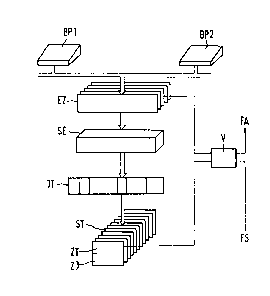Some of the information on this Web page has been provided by external sources. The Government of Canada is not responsible for the accuracy, reliability or currency of the information supplied by external sources. Users wishing to rely upon this information should consult directly with the source of the information. Content provided by external sources is not subject to official languages, privacy and accessibility requirements.
Any discrepancies in the text and image of the Claims and Abstract are due to differing posting times. Text of the Claims and Abstract are posted:
| (12) Patent: | (11) CA 1276298 |
|---|---|
| (21) Application Number: | 1276298 |
| (54) English Title: | METHOD OF ENTERING SETTING COMMANDS IN A COMPUTER-CONTROLLEDINTERLOCKING |
| (54) French Title: | METHODE D'INTRODUCTION D'INSTRUCTIONS DE REGLAGE DANS UN DISPOSITIF DE VERROUILLAGE COMMANDE PAR ORDINATEUR |
| Status: | Expired and beyond the Period of Reversal |
| (51) International Patent Classification (IPC): |
|
|---|---|
| (72) Inventors : |
|
| (73) Owners : |
|
| (71) Applicants : |
|
| (74) Agent: | SMART & BIGGAR LP |
| (74) Associate agent: | |
| (45) Issued: | 1990-11-13 |
| (22) Filed Date: | 1987-10-19 |
| Availability of licence: | N/A |
| Dedicated to the Public: | N/A |
| (25) Language of filing: | English |
| Patent Cooperation Treaty (PCT): | No |
|---|
| (30) Application Priority Data: | ||||||
|---|---|---|---|---|---|---|
|
Abstract
Method of Entering Setting Commands in a Computer-
Controlled Interlocking
A method is disclosed for converting operator inputs
into control commands in a computer-controlled inter-
locking. For standard inputs, a search method is used
instead of a complicated and time-consuming syntax
analysis. Using a pseudorandom technique, a search
code is determined from the text entered into an in-
put device. With the and of this search code, the
control command assigned to the input text is found
in a previously compiled list of all control commands.
Before being processed, the control command found is
checked for agreement with the input by a direct
comparison.
Note: Claims are shown in the official language in which they were submitted.
Note: Descriptions are shown in the official language in which they were submitted.

2024-08-01:As part of the Next Generation Patents (NGP) transition, the Canadian Patents Database (CPD) now contains a more detailed Event History, which replicates the Event Log of our new back-office solution.
Please note that "Inactive:" events refers to events no longer in use in our new back-office solution.
For a clearer understanding of the status of the application/patent presented on this page, the site Disclaimer , as well as the definitions for Patent , Event History , Maintenance Fee and Payment History should be consulted.
| Description | Date |
|---|---|
| Time Limit for Reversal Expired | 1999-11-15 |
| Letter Sent | 1998-11-13 |
| Grant by Issuance | 1990-11-13 |
There is no abandonment history.
| Fee Type | Anniversary Year | Due Date | Paid Date |
|---|---|---|---|
| MF (category 1, 7th anniv.) - standard | 1997-11-13 | 1997-10-20 |
Note: Records showing the ownership history in alphabetical order.
| Current Owners on Record |
|---|
| STANDARD ELEKTRIK LORENZ AKTIENGESELLSCHAFT |
| Past Owners on Record |
|---|
| HARALD SCHULZ |
| JURGEN KEHRER |